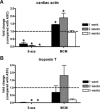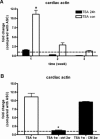Differentiation of human adipose-derived stem cells into beating cardiomyocytes
- PMID: 20070436
- PMCID: PMC3823119
- DOI: 10.1111/j.1582-4934.2010.01009.x
Differentiation of human adipose-derived stem cells into beating cardiomyocytes
Abstract
Human adipose-derived stem cells (ASCs) may differentiate into cardiomyocytes and this provides a source of donor cells for tissue engineering. In this study, we evaluated cardiomyogenic differentiation protocols using a DNA demethylating agent 5-azacytidine (5-aza), a modified cardiomyogenic medium (MCM), a histone deacetylase inhibitor trichostatin A (TSA) and co-culture with neonatal rat cardiomyocytes. 5-aza treatment reduced both cardiac actin and TropT mRNA expression. Incubation in MCM only slightly increased gene expression (1.5- to 1.9-fold) and the number of cells co-expressing nkx2.5/sarcomeric alpha-actin (27.2% versus 0.2% in control). TSA treatment increased cardiac actin mRNA expression 11-fold after 1 week, which could be sustained for 2 weeks by culturing cells in cardiomyocyte culture medium. TSA-treated cells also stained positively for cardiac myosin heavy chain, alpha-actin, TropI and connexin43; however, none of these treatments produced beating cells. ASCs in non-contact co-culture showed no cardiac differentiation; however, ASCs co-cultured in direct contact co-culture exhibited a time-dependent increase in cardiac actin mRNA expression (up to 33-fold) between days 3 and 14. Immunocytochemistry revealed co-expression of GATA4 and Nkx2.5, alpha-actin, TropI and cardiac myosin heavy chain in CM-DiI labelled ASCs. Most importantly, many of these cells showed spontaneous contractions accompanied by calcium transients in culture. Human ASC (hASC) showed synchronous Ca(2+) transient and contraction synchronous with surrounding rat cardiomyocytes (106 beats/min.). Gap junctions also formed between them as observed by dye transfer. In conclusion, cell-to-cell interaction was identified as a key inducer for cardiomyogenic differentiation of hASCs. This method was optimized by co-culture with contracting cardiomyocytes and provides a potential cardiac differentiation system to progress applications for cardiac cell therapy or tissue engineering.
Figures







Similar articles
-
Trichostatin a promotes cardiomyocyte differentiation of rat mesenchymal stem cells after 5-azacytidine induction or during coculture with neonatal cardiomyocytes via a mechanism independent of histone deacetylase inhibition.Cell Transplant. 2012;21(5):985-96. doi: 10.3727/096368911X593145. Epub 2011 Sep 22. Cell Transplant. 2012. PMID: 21944777
-
Formation of functional gap junctions in amniotic fluid-derived stem cells induced by transmembrane co-culture with neonatal rat cardiomyocytes.J Cell Mol Med. 2013 Jun;17(6):774-81. doi: 10.1111/jcmm.12056. Epub 2013 May 2. J Cell Mol Med. 2013. PMID: 23634988 Free PMC article.
-
Differentiation of human adipose-derived stem cells towards cardiomyocytes is facilitated by laminin.Cell Tissue Res. 2008 Dec;334(3):457-67. doi: 10.1007/s00441-008-0713-6. Epub 2008 Nov 7. Cell Tissue Res. 2008. PMID: 18989703
-
Extracellular Matrix in Regulation of Contractile System in Cardiomyocytes.Int J Mol Sci. 2019 Oct 11;20(20):5054. doi: 10.3390/ijms20205054. Int J Mol Sci. 2019. PMID: 31614676 Free PMC article. Review.
-
Stem cell differentiation: cardiac repair.Cells Tissues Organs. 2008;188(1-2):202-11. doi: 10.1159/000112846. Epub 2007 Dec 20. Cells Tissues Organs. 2008. PMID: 18160823 Free PMC article. Review.
Cited by
-
Comparison of similar cells: Mesenchymal stromal cells and fibroblasts.Acta Histochem. 2020 Dec;122(8):151634. doi: 10.1016/j.acthis.2020.151634. Epub 2020 Oct 12. Acta Histochem. 2020. PMID: 33059115 Free PMC article. Review.
-
Ischemic preconditioning promotes intrinsic vascularization and enhances survival of implanted cells in an in vivo tissue engineering model.Tissue Eng Part A. 2012 Nov;18(21-22):2210-9. doi: 10.1089/ten.TEA.2011.0719. Epub 2012 Jul 11. Tissue Eng Part A. 2012. PMID: 22651554 Free PMC article.
-
A Thin Layer of Decellularized Porcine Myocardium for Cell Delivery.Sci Rep. 2018 Nov 1;8(1):16206. doi: 10.1038/s41598-018-33946-2. Sci Rep. 2018. PMID: 30385769 Free PMC article.
-
Over-expression of Nkx2.5 and/or cardiac α-actin inhibit the contraction ability of ADSCs-derived cardiomyocytes.Mol Biol Rep. 2012 Mar;39(3):2585-95. doi: 10.1007/s11033-011-1011-z. Epub 2011 Jun 21. Mol Biol Rep. 2012. PMID: 21691712
-
Methods of Isolation, Characterization and Expansion of Human Adipose-Derived Stem Cells (ASCs): An Overview.Int J Mol Sci. 2018 Jun 28;19(7):1897. doi: 10.3390/ijms19071897. Int J Mol Sci. 2018. PMID: 29958391 Free PMC article. Review.
References
-
- World Health Organization . Available at. http://www.who.int/mediacentre/factsheets/fs317/en/index.html. Accessed November 1, 2008.
-
- Eschenhagen T, Zimmermann WH. Engineering myocardial tissue. Circ Res. 2005;97:1220–31. - PubMed
-
- Ott HC, Matthiesen TS, Goh SK, et al. Perfusion-decellularized matrix: using nature’s platform to engineer a bioartificial heart. Nat Med. 2008;14:213–21. - PubMed
-
- Zammaretti P, Jaconi M. Cardiac tissue engineering: regeneration of the wounded heart. Curr Opin Biotechnol. 2004;15:430–4. - PubMed
-
- Leor J, Amsalem Y, Cohen S. Cells, scaffolds, and molecules for myocardial tissue engineering. Pharmacol Ther. 2005;105:151–63. - PubMed
Publication types
MeSH terms
Substances
LinkOut - more resources
Full Text Sources
Other Literature Sources
Medical
Research Materials
Miscellaneous

